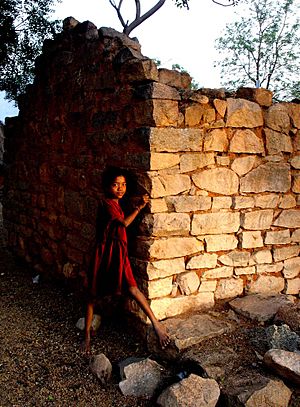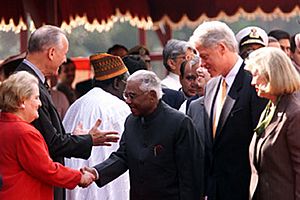Dalit facts for kids
Dalit is a word that describes groups of people, mainly in India, who have faced a lot of unfair treatment and challenges throughout history. The word "Dalit" comes from Sanskrit and Hindi, meaning "broken" or "scattered." Before 1935, the British government in India used a term called "Depressed Classes" for these groups.
A very important leader and thinker named B. R. Ambedkar (1891–1956) helped make the word "Dalit" well-known. He believed that all people who were treated unfairly, including women, small farmers, and people from certain castes, should be included in the definition of Dalits. He even started a group called the "Labour Party" for all these people.
Dr. Ambedkar worked hard to get special voting rights for Dalits during the time of British rule in India. This was part of something called the "Communal Award" by Ramsay MacDonald. It would have allowed Dalits to choose their own leaders and have a stronger voice.
In 1932, the British suggested these special voting groups for Dalits. Dr. Ambedkar supported this idea. However, another famous leader, Mahatma Gandhi, disagreed. This led to an agreement called the Poona Pact. Because of this pact, the Government of India Act of 1935 was created. This law set aside special seats for the "Depressed Classes," who were then officially called "Scheduled Castes."
Today, the term "Dalit" is used by many people who were once called "Untouchables." They use "Dalit" as a way to show their strength and to fight against the social separation caused by the caste system. New leaders, like Kanhaiya Kumar, also use this broad definition of "Dalit," meaning it can include anyone struggling to make a living, even if they are from a different background. B. R. Ambedkar himself was from the Mahar community. In the 1970s, the word "Dalit" became even more popular when an activist group called the Dalit Panthers started using it. Over time, political groups also began using the term.
Contents
What is Untouchability?
Untouchability is an old form of discrimination based on the caste system. It's not just about not being able to touch someone. It's a harmful way of thinking about a minority group that leads to many unfair actions and rules.
Social Status and Jobs
Being a Dalit often meant facing the unfair label of "untouchability." This was because their traditional jobs were seen as low-status or unclean. These jobs included difficult tasks like handling dead animals or cleaning sewers and latrines.
Types of Discrimination Faced
Dalits have faced many different kinds of discrimination. Here are some examples:
- In villages, Dalits were often not allowed to join in community activities. This included going into temples, sitting in main village areas, taking part in religious events, or eating with others during ceremonies.
- They were also not allowed to use the same things as non-Dalits. They couldn't rent or enter homes of non-Dalits, use the same water wells, or eat and drink from the same dishes.
- In schools, Dalit children were sometimes made to sit separately from other students during lunch. They were also often the only ones asked to clean the school latrines.
- They were sometimes forced to wear special markers, like wristbands, to show their caste at school.
- They were often not allowed to marry people from other castes.
- They faced rules that stopped them from running in elections or even voting.
- They were sometimes not allowed to raise the national flag on important days like Independence or Republic Day.
- They were forced to vote for or against certain candidates during elections.
- They faced social boycotts (being ignored or excluded) by other groups if they refused to do certain "duties."
Education and Reading Skills
In 1991, a study showed that the number of Dalits who could read and write was 37.41%. This was lower than the 57.69% for non-Dalits. The unfair treatment in schools made it harder for Dalit children to stay in school and learn to read and write. The 1991 census in India reported that Dalit communities had some of the lowest reading and writing skills in the country. Only about 30% of Dalit children were known to have basic reading and writing abilities.
Health Challenges
Sadly, many Dalit children face health problems. Half of India's Dalit children are not getting enough food. About 21% are "severely underweight," and 12% die before they turn five. Between 1998 and 1999, at least 50% of Dalit women suffered from anemia (a condition where you don't have enough healthy red blood cells). These health issues and high rates of child mortality are strongly connected to the low quality of life caused by poverty, lack of education, and discrimination.
Efforts for Social Change
Many efforts have been made to stop caste-based discrimination in India. In the 1930s, the ideas of B. R. Ambedkar and Mahatma Gandhi started to change how people thought about the Dalit minority. In 1949, the Indian constitution made "Untouchability" illegal. Indian law now does not allow the practice of a caste system. Discrimination against the Dalit minority has become a very important issue for human rights and politics. Even with these laws, Dalits in rural areas still face some effects of this slow-to-disappear discrimination.
Progress and Hope
Today, Dalit movements continue to work for equality and the full use of the Communal Award. These movements, like The Dalit Panther Movement, the Dalit Mahasabha, and the Dalit Sangharsh Samithi, became active in the 20th century. The progress made in recent decades gives hope for more equality in Indian society. In 1997, Kocheril Raman Narayanan became the first Dalit person to be elected President of India. Another important political figure is Mayawati Kumari, who leads the Bahujan Samaj Party (BSP), a party that represents Dalits. She has been elected four times as the Chief Minister of Uttar Pradesh, which is India’s most populated state.
Organizations Helping Dalits
The National Campaign on Dalit Human Rights (NCDHR) was started in 1998 by Dalit human rights activists. It is one of many groups working to end caste discrimination. Its main goals are "to make the government responsible for all human rights violations against Dalits; to make regular people more aware of the Dalit problem; and to get justice for Dalits who have faced discrimination and violence."
The International Dalit Solidarity Network, started in 2000, is another organization focused on caste discrimination and similar unfair treatment based on work and family background. It has grown into a network of groups from countries like those in South Asia and even West Africa.
Images for kids
-
A Valmiki Temple in the UK. Because of caste separation, Mazhabi Sikhs and Hindu Churas have built their own temples across Britain. Some Valmiki temples have a copy of the Guru Granth Sahib (Sikh holy book), and Mazhabi Sikhs and Valmikis pray together.
See also
 In Spanish: Paria (casta) para niños
In Spanish: Paria (casta) para niños






